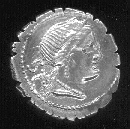

| Introduction | Brief History | Roman Coins | Buying and Storage |
| Fakes and Authentification | Identification | Roman Coin Denominations | Grading |
| Coin of the Month |
| Important update... There are efforts in Congress to pass laws that would effectively make collecting ancient coins illegal under the guise of preventing the sale of looted antiquities. These laws are overly broad and should be defeated. Please support The Ancient Coin Collectors Guild in their effort to inform people about these bills and to defeat them. |
| While I am not a dealer, I still do have a few ancient coins for sale (really!). |
| Feel free to suggest additional topics I should cover, ask any questions, or report any mistakes. |


Welcome to Brad's Introduction to Ancient Coins!
Here you'll find some basic information about the hobby of identifying and collecting Ancient (mostly Roman) coins.
Let me start by describing the first coin you see here. At left is the obverse or front of the coin. It depicts the head of Venus, the Roman goddess of beauty and love. At right is the reverse or back of the coin. It shows Victory riding a triga (a three-horse chariot). This coin has a chunk of metal missing where the horse's front legs are, but is otherwise in a very nice state of preservation.
 Below the chariot is an inscription in the
exergue
(the area below the main design on the reverse of the coin).
reading
C NAE BALB
This is shown at right,
enlarged and digitally enhanced, though still more difficult to read
than it is on the coin itself.
It is an abbreviation of the name of the person who held the post of
moneyer
(a person authorized to mint coins)
when this coin was minted. From historical information,
we can find out that this was C. Naevius Balbus who held
the office in Republican Rome in 79 BC. So we know when this coin was minted
to the year, even though it is over two-thousand years old!
Below the chariot is an inscription in the
exergue
(the area below the main design on the reverse of the coin).
reading
C NAE BALB
This is shown at right,
enlarged and digitally enhanced, though still more difficult to read
than it is on the coin itself.
It is an abbreviation of the name of the person who held the post of
moneyer
(a person authorized to mint coins)
when this coin was minted. From historical information,
we can find out that this was C. Naevius Balbus who held
the office in Republican Rome in 79 BC. So we know when this coin was minted
to the year, even though it is over two-thousand years old!
The coin is made out of silver, and the edge is serrated. This was done by Roman slaves, though the reason is not known for sure. This coin is called a denarius, and was one of the main denominations (currency value) of coinage in ancient Rome. In the United States, there is the dollar and the cent. In Rome, there were many denominations, and as the fate of Rome changed, the denominations and the metal content of the coins often changed as well. Learning about these details is important for a variety of reasons, but there are many books and web sites to help you.
As you can see, even a rudimentary study of this one coin touches on the fields of history, geography, economics, art, and mythology. The first three of these are interests of mine, and the artwork on many of these coins is surprisingly elaborate and sophisticated.
At this point you might be wondering how a person might possess such an old and rare coin. While it may be quite old, it is actually not all that rare. Many millions or even billions of coins were minted by ancient empires over the course of a thousand years, and many millions of these survive today. Coins have been found by the thousands in Eastern Europe in recent years and sold uncleaned by many dealers. These are often in poor condition, and can sell for than a dollar each!
Before going on, I should say that I'm not a historian, archeologist, or museum curator. While I spend a lot of time identifying the coins I have, I'm not a scholar, and some of the information on this page may not entirely accurate. If you notice any errors, or have any comments, questions or suggestions, please let me know. Also note that I am not a dealer, and do not offer any of the coins pictured or described for sale, I do have a few coins for sale. Click here to see the list of coins I'm selling.
There are many other wonderful web sites about ancient coins, such as Doug Smith's or Augustus', and of course, lots of information in Wikipedia and I do recommend that you visit these if this site piques your interest. But I wanted to make my own page to explain why ancient coins interest me, give some basic information, and show off a few of my favorites.
If you have any questions or comments, please
Send e-mail to me at
 .
.
Continue to Brief History of Ancient Coins.
Last updated December 22, 2023.